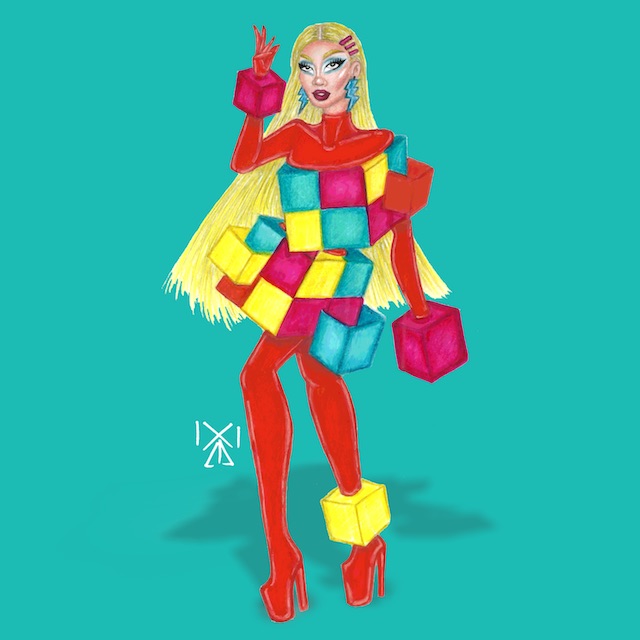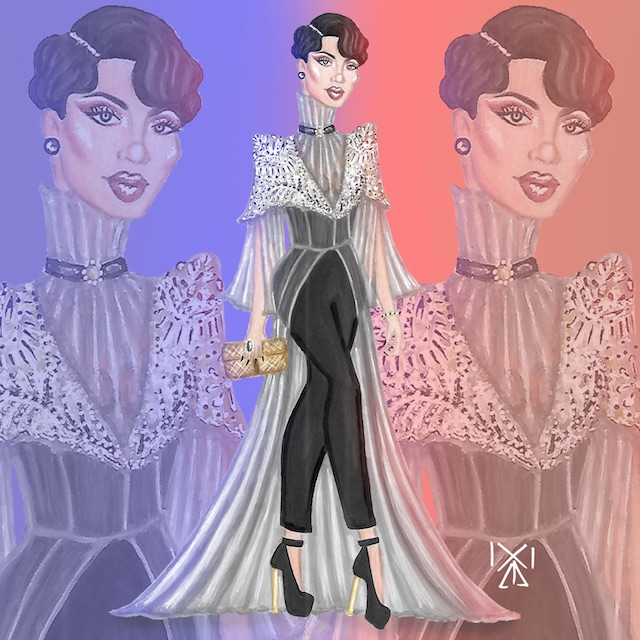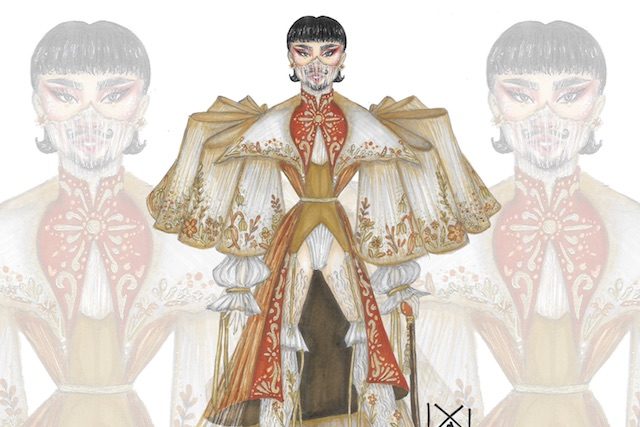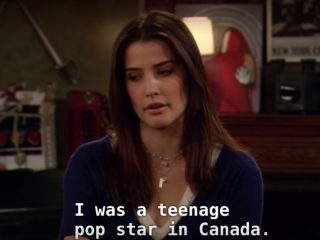In case you missed it on your social media feeds: The virtual Met Gala hosted by HF (high fashion) Twitter happened on May 5, Tuesday (Philippine time). “Attendees” paid tribute to the Metropolitan Museum of Art’s 150th anniversary by submitting creations based on the 2020 theme “About Time: Fashion and Duration.”
One submission that caught our eye was from 18-year-old Filipino designer Ron Roxas.
Roxas is currently a student at Malayan Colleges Laguna and is part of a fashion student organization. He is also head designer of his namesake brand, which was officially established just last year with a collection of zodiac-inspired headpieces.
“It really means so much to me,” Ron Roxas tells Preen.ph. “As a small starting designer to be recognized by one of the most known figures in HF Twitter, I’m on cloud nine”
For the virtual Met Gala, he created a piece inspired by “18th century Rococo and [a] 19th century Maria Clara dress of our Filipino heritage, infused with queer modernity.” HF Twitter creator Aria Olson saw this and commented “lovely!!” on his Instagram post.
“It really means so much to me,” Roxas tells Preen.ph. “As a small starting designer to be recognized by one of the most known figures in HF Twitter, I’m on cloud nine.”
We spoke to Roxas about how he conceptualized his virtual Met Gala creation, his fashion journey, future plans, and how he’s spending his time during quarantine.
First off, how are you? How is the enhanced community quarantine treating you and your family? How has it affected you as a creative/designer?
I’m really fortunate to say that my family and I are doing well during this difficult time. The present situation of the world during this crisis, particularly how our country’s leaders are ‘trying’ to address the pandemic, makes me really worried and anxious.
My productivity in doing school works for the past month was seemingly low. I felt really unmotivated. So, I resorted to procrastinating and started binging shows. (I’ve finished about 12 Thai gay series already.) I also tried to use art as a way to escape reality, which included creating various portraits and designs.

Still, as a creative whose inspirations are pulled mostly from everyday real-life experiences, this quarantine gave me a hard time to curate works. I feel like the sudden pause of society [affected my excitement] in creating new designs and concepts.
How did you get into fashion and designing?
Growing up as an effeminate boy, I’ve always been fascinated with dolls, especially Bratz. I usually play with them, dress them up, and even create doll clothes with my two sisters. Ever since my cousin showed me his illustrations of gorgeous wedding gowns, I instantly knew that I wanted to do something similar as a career. I started sketching my own designs as early as fourth or fifth grade and eventually, I developed my skills in fashion illustration.
Growing up as an effeminate boy, I’ve always been fascinated with dolls, especially Bratz. I usually play with them, dress them up, and even create doll clothes with my two sisters
Who inspired you to pursue fashion and start your own brand?
Hayden Williams was one of the [major] prominent influences for me to pursue my desire to design clothes and garments; [he inspired me to] illustrate them in a very elaborate manner. Soon, I became more aware of the big global fashion brands and started to watch shows on YouTube, particularly Thierry Mugler, Alexander McQueen, Valentino, and Iris van Herpen, to name a few.
My passion for fashion grew more when I became a senior high school student and became part of the Malayan Haus of Fashion and Arts (or The Haus), a fashion org in our school. My brand was finally established only a year ago after I presented my collection of wire sculpture zodiac-inspired headdresses for my org’s fashion show.

Currently, I am the acting vice president of our organization. Thanks to them, I grew more as a designer and a creative who finally made his sketches come to life.
How would you describe the pieces you create? Where do you usually draw inspiration from?
I would always describe my pieces to be subversive to the normative ideals, which make them more personal. At the same time, my pieces still reference some culture or tradition. In a way, it is intersubjective, a fusion of both personal and objective beauty. My brand’s tagline is “undefinable beauty” and I think the action of constantly trying to define and redefine the existing ideals of beauty perfectly shows that.
I always tend to explore the idea of gender through clothing. I always make sure to inject a message when creating my collections since art will always be political. It would be not just meaningful for me but also for the people who will see the pieces. I’m also inspired by the creations of Alexander McQueen, Thierry Mugler, Pierpaolo Piccioli, and Iris van Herpen.

What was your thought process while sketching out your virtual Met Gala design?
Upon hearing about the Met Gala theme, I initially wanted to fuse a Western period garment with our very own traditional Filipiniana and make something grand, modern, and uniquely queer. After I finished looking at several photos from the 18th century Rococo and 19th century Filipino fashion, I decided to play with the idea of masculinity and femininity as central concepts of my design. That’s why I picked the three-piece court suit of the 18th century Rococo to symbolize the masculinity part and the 19th century Maria Clara dress to symbolize femininity.
I wanted to convey the message that it is totally okay for cis males to wear dresses, makeup, do drag, and be expressive when it comes to their femininity
The three-piece court suit for men was accessorized with floral embroideries; makeup was usually worn and there was an abundance of lace. Meanwhile, the Maria Clara dress’ humongous sleeves somehow reminded me of armor and modern football pads, which just show the flexibility of ‘norms.’ I also referenced known Filipino flowers like waling-waling and ylang-ylang in the embroideries.
READ MORE: ‘Maria Clara’ is not always the best definition of Filipinas
At first, I wanted the outfit to have a pair of calf-length pants, but I opted for a high-cut undergarment to go with the corset and the theme of queer modernity. With that, I accentuated my model’s facial hair and leg hairs, which is a play on society’s gender expectations and a widening of the gender spectrum.
Being genderqueer, this message is really important for me and I think my experiences became my own inspiration in creating this look. In fact, I see myself wearing this piece. I see this as a true expression of who I am. I wanted to convey the message that it is totally okay for cis males to wear dresses, makeup, do drag, and be expressive when it comes to their femininity. At the same time, you can explore your masculinity and other possibilities of your gender as long as you are not harming others and you’re being genuine to yourself.
You can explore your masculinity and other possibilities of your gender as long as you are not harming others and you’re being genuine to yourself
As a young Filipino designer, what does it mean for you to receive a reaction from HF Twitter’s owner for this virtual Met Gala piece?
It felt really validating. I was really happy and also in disbelief that it reached a lot of people. I’m really thankful that I got the opportunity to spread even just a little part of our Filipino culture. I’m still pinching myself right now.
If you were to dress someone for the Met Gala in the future, who would it be?
Billy Porter is a dream client of mine because of his contribution to the LGBTQIA+ community. The way he unapologetically walked the Oscars red carpet in the iconic Christian Siriano tuxedo gown really inspired me to also live my truth. But in terms of Filipino personalities, it would be an honor to dress BJ Pascual and Sef Loseo. I’ve been a big fan of them and their amazing artistry.
What’s next for you? Do you have any projects lined up?
Currently, I’m working on a collection that was supposed to be shown at our org’s annual fashion show. The collection is called “Binhi,” which is inspired by horticulture and farming. The designs will also play on gender expectations. Also, people can expect more fashion illustrations [on my Instagram feed] in the upcoming days. Hopefully, I’ll continue my journey in studying fashion for college.
Photos courtesy of Ron Roxas
Follow Preen on Facebook, Instagram, Twitter, YouTube, and Viber
Related stories:
The iconic Met Gala looks of years past
WATCH: Anna Wintour’s state of the Met Gala address
Carl Jan Cruz’s Met Gala 2019 debut was totally unplanned
Puey Quiñones made his Met Gala debut—next, a Manila comeback


